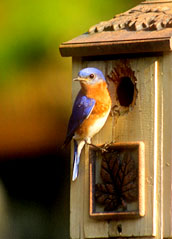 The supply of natural nesting cavities for bluebirds and other native cavity nesters has been greatly reduced due to the continuous clearing of land for housing and industrial developments. Many old trees have been cut down for firewood and wooden fence posts have long been replaced with metal posts. The present situation dictates that man offer an alternative nesting place for the shortage of natural ones he had caused.
The supply of natural nesting cavities for bluebirds and other native cavity nesters has been greatly reduced due to the continuous clearing of land for housing and industrial developments. Many old trees have been cut down for firewood and wooden fence posts have long been replaced with metal posts. The present situation dictates that man offer an alternative nesting place for the shortage of natural ones he had caused.
Bluebirds are known to appreciate man-made nest boxes although there are some specifications that have to be noted in making one. The primary material to be used is wood, preferably cedar or redwood. Other types of wood can be used such as plywood as long as they are at least 3/4“thick. Pressure treated wood should be avoided as it include toxic compounds that will be harmful to the birds. Boxes can be painted or stained with a light color on the outside and left natural on the inside.
Birdhouses for Eastern Bluebirds should be approximately 4 x 4 inches to 5 x 5 inches with entry holes that are either 1 ½ inch round holes , 1 3/8 x 2 ¼ vertical oval holes or 1 1/8 inch horizontal slot entrances. Western and Mountain Bluebird boxes should at least be 5 x 5 inches to 5 ½ x 5 ½ inches to accommodate their larger clutch sizes. Mountain Bluebirds need an entrance hole of 1 9/16” while Western Bluebirds use a 1 ½” hole. In case the ranges overlap, it is best to use a 1 9/16” hole. Oval holes should only be used in Eastern Bluebird boxes with moderate to small dimensions to reduce the possibility of Starling use.
 Bluebird houses should readily open either from the top, side or front to facilitate box monitoring and cleaning. The design should be such that it readily and securely mounts on a support post such as water pipe or electrical conduit pipes. Fence posts are acceptable mounts on area where raccoons are rare. It is best to have the back extend beyond the main box body or above the box to allow attachment with the use of screen nails, pipe clamps, wires or u-bolts.
Bluebird houses should readily open either from the top, side or front to facilitate box monitoring and cleaning. The design should be such that it readily and securely mounts on a support post such as water pipe or electrical conduit pipes. Fence posts are acceptable mounts on area where raccoons are rare. It is best to have the back extend beyond the main box body or above the box to allow attachment with the use of screen nails, pipe clamps, wires or u-bolts.
Drainage holes must be provided in the box bottom to allow any water that might have entered the box to drain as well as to provide air circulation to keep nesting materials dry. The roof should provide sufficient overhang beyond box entrance or vent holes to minimize the possibility of rain entering these openings. Vents providing cross ventilation should be present near the box peak. There should be provision for plugging or covering vent holes during cold weather periods early in the nesting period.
Perches should not be used on Bluebird birdhouses since they only facilitate harassment from predators and competing species aside from the fact that they are not needed by Bluebirds. The birdhouse should be predator-resistant through the use of heavily greased pipes to deter most climbing predators. A 5-inch roof overlay above the entrance hole will discourage cats and raccoons. The placement of a rectangle of ½ inch hardware cloth around the entrance hole can stop predators from reaching down into the nest box.
One can easily set up a Bluebird trail with the right habitat. A suitable Bluebird habitat is an open rural country with scattered trees with low or sparse ground cover. There should also be perch sites such as fence lines, wires or tree branches. Bluebird houses should be mounted in such a way that the entrance hole is approximately five feet above the ground and facing away from prevailing winds. Boxes in a Bluebird trail are best placed approximately 100 yards from each other for Western Bluebirds, 125 to 150 yards for Eastern Bluebird and 200 to 300 yards for Mountain Bluebirds. It is not recommended for anyone to put a Bluebird box which he/she do not intend to monitor.